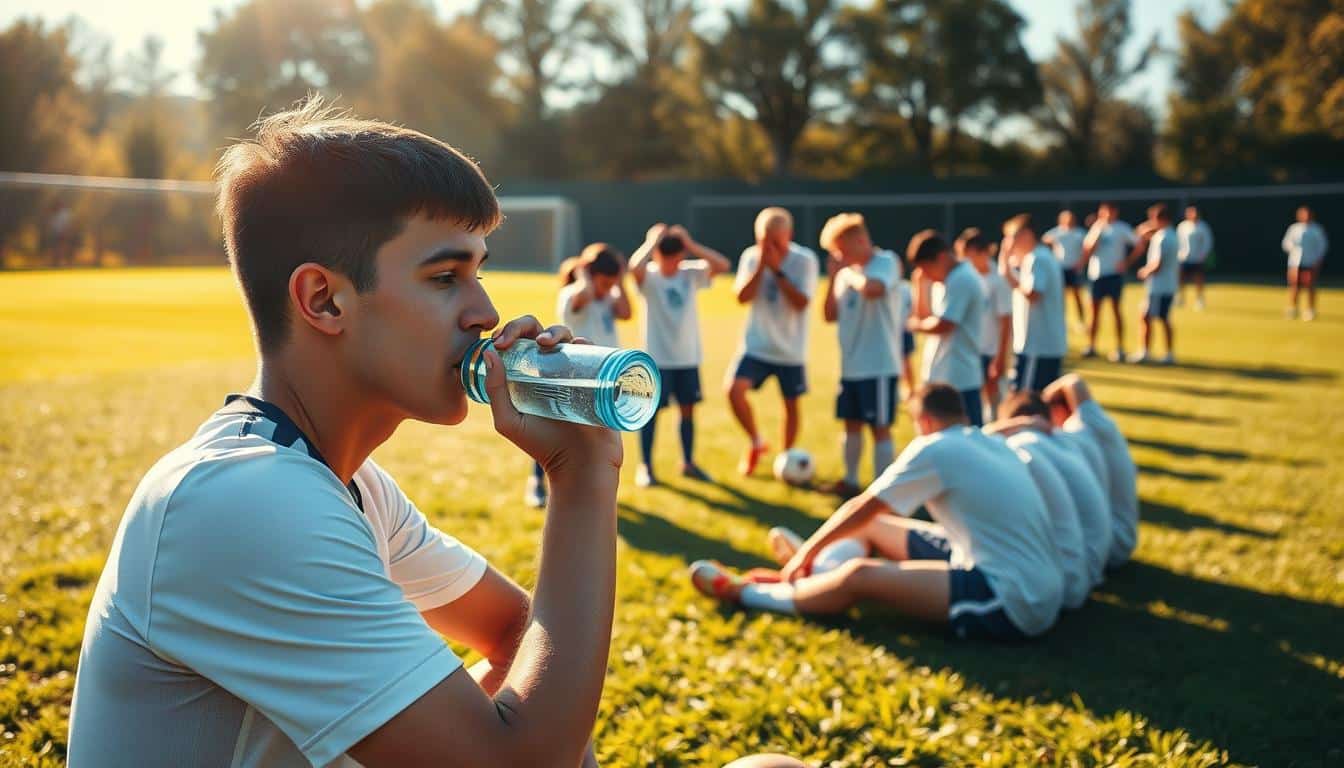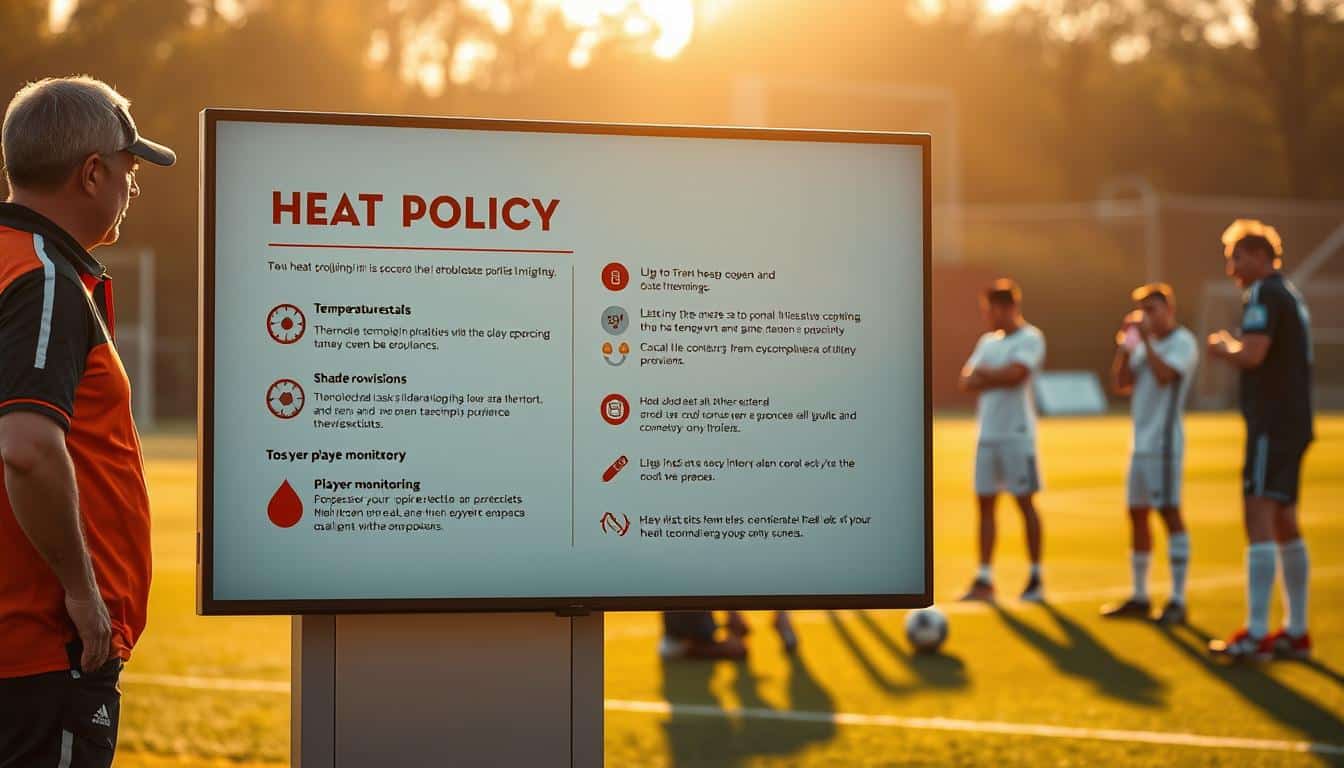Stay Safe: Soccer Heat Safety Tips for Kids Guide

Playing outdoor sports in sweltering conditions can turn fun into risk fast. As temperatures rise, young athletes need smart strategies to stay healthy and perform their best. This guide offers actionable steps to protect players while aligning with trusted programs like U.S. Soccer’s Recognize to Recover initiative.
Designed for parents and coaches, you’ll learn how to evaluate weather risks, adjust practice plans, and spot early warning signs of overheating. We break down hydration basics, lightweight clothing choices, and when to pause play. Every tip prioritizes simplicity, so you can focus on what matters: keeping kids safe and active.
Key Takeaways
- Check weather forecasts and field conditions before practices or games
- Schedule regular water breaks every 15-20 minutes
- Choose breathable, light-colored uniforms for better airflow
- Learn to recognize dizziness or nausea as potential heat stress signals
- Follow nationally recognized guidelines for modifying play intensity
Understanding Heat Risks for Young Soccer Players
High temperatures don’t just make athletes sweat—they push the body’s cooling systems into overdrive. When summer temperatures spike, young players face unique challenges because their bodies release heat slower than adults. This makes them more vulnerable during intense physical activity.
Health Impacts of Extreme Temperatures
Prolonged exposure to extreme weather disrupts natural temperature regulation. The body redirects energy to cool itself, reducing stamina and focus. In severe cases, this can lead to heat-related illnesses like heat stroke—a life-threatening condition where internal temperatures exceed 104°F.
Common signs of overheating include flushed skin, rapid breathing, and muscle cramps. Fatigue or confusion often follows, signaling the need for immediate intervention. Always check local weather forecasts before practices, as humidity and direct sunlight amplify risks.
Recognizing Early Warning Signs
Watch for subtle changes: dizziness, nausea, or headaches. These symptoms often appear before more serious issues develop. According to youth sports safety guidelines, coaches should pause play if two or more players show these signs.
Create a routine to monitor environmental conditions and physical responses. Use rest breaks to assess hydration levels and energy. Remember—preventing heat-related emergencies starts with understanding how weather and exertion interact.
Recognizing the Signs of Heat Illness
Your body sends clear signals when struggling to cope during physical activity. Learning these warnings helps prevent minor discomfort from becoming a crisis. Coaches and parents should prioritize symptom awareness, especially during high-intensity drills or humid days.
Identifying Heat Exhaustion Indicators
Heat exhaustion often starts subtly. Look for heavy sweating paired with pale, clammy skin. Athletes might complain of headaches or muscle cramps. You’ll notice faster breathing and a weak pulse. If someone stops drinking water or skips hydration breaks, these could be red flags.
Dizziness and nausea frequently appear next. Young players might sit down suddenly or struggle to keep up. According to U.S. Soccer’s guidelines, confusion or irritability means it’s time to act. Move them to shade immediately and offer small sips of water.
Spotting Symptoms of Heat Stroke
Heat stroke demands urgent medical care. Watch for a lack of sweat despite hot conditions. The skin turns red and feels extremely warm. Athletes may vomit, slur words, or collapse. Body temperatures above 104°F require emergency cooling methods.
Coaches should document these signs and adjust practice plans. For example, if two players show symptoms within 30 minutes, pause the session. Always check weather conditions before resuming play. Quick recognition saves lives—trust your instincts if something seems off.
Hydration Strategies and Water Intake for Kids
Proper fluid intake acts as your first defense against heat-related challenges during physical activity. Young athletes lose water faster than adults, making consistent hydration non-negotiable. Let’s break down how to time drinks and choose the right fluids.
Timing Matters
Start hydrating 2 hours before practice with 16-20 ounces of water. During play, aim for 5-10 ounces every 20 minutes. Afterward, replace lost fluids within 30 minutes. Adjust amounts based on activity intensity and weather—add 4-8 ounces for every 15 minutes in extreme conditions.
| Fluid Type | Best Use | Key Benefits |
|---|---|---|
| Water | Short sessions (under 60 mins) | Quick absorption, zero additives |
| Sports Drinks | Extended play (1+ hours) | Replenishes electrolytes lost through sweat |
Choosing Your Fluid
Water works best for most practices. Reserve sports drinks for tournaments or high-intensity days when sweat loss exceeds normal levels. Watch for dehydration symptoms like dark urine or dry lips—these signal immediate fluid needs.
Sync hydration breaks with your practice schedule. For example, pause every quarter during games or after skill drills. Remember: Proper fluid intake helps maintain energy levels and prevents muscle cramps throughout the day.
Proper Clothing and Gear in Hot Weather
What your young athlete wears can make a big difference under the sun. The right gear helps their body stay cool even when temperatures climb. Let’s explore smart fabric choices and practical tips that support performance while lowering health risks.
Why Fabric Choice Matters
Lightweight, breathable materials like polyester blends wick moisture away from the skin. This allows sweat to evaporate quickly, preventing that sticky feeling during drills. Loose-fitting shirts and shorts create airflow, acting like personal cooling systems.
Dark colors absorb sunlight, turning uniforms into ovens. Opt for light-colored outfits that reflect rays instead. Many leagues now recommend moisture-wicking jerseys as standard gear for warm-weather activities.
Accessories play a role too. Wide-brimmed hats or visors shield faces from direct sun—a simple tip that makes outdoor time safer. Some parents add cooling towels around necks between plays. Remember: Comfortable players can focus better and enjoy the game longer.
Always check forecasts before packing practice clothes. If the mercury tops 90°F, consider UV-protective sleeves. These adjustments reduce the risk of heat-related illnesses while keeping kids in the action. Following these tips ensures gear works with the body, not against it.
Modifying Soccer Practices for Heat Safety
Smart adjustments to training routines can turn scorching days into safe play opportunities. Focus on two key strategies: timing sessions wisely and building recovery into every drill. These changes help young athletes avoid health risks while maintaining skill development.
Scheduling During Cooler Times
Plan outdoor activities before 10 AM or after 6 PM when temperatures drop. Many leagues follow guidelines suggesting 20% shorter practices when thermometers hit 85°F. Reduce sprint drills during peak heat—swap them for tactical discussions or shaded stretching.
Work-to-rest ratios matter. For example:
- 1:3 ratio in 90°F+ conditions (10 minutes activity, 30 minutes rest)
- Mandatory 5-minute breaks every 15 minutes of play
Integrating Regular Cooling Breaks
Pause every 20 minutes for hydration and shade access. Use these breaks to check for flushed faces or excessive sweat—early signs of trouble. Set up misting stations or cold towel stations to help bodies reset.
If someone reports dizziness or nausea, act fast:
- Move them to a cool area immediately
- Offer small sips of water
- Apply ice packs to neck and wrists
Coaches should carry thermometers to monitor field temperatures. When surfaces exceed 120°F, modify activities or relocate. These steps prevent most cases of heat exhaustion and reduce heat illness risks significantly.
Essential Soccer Heat Safety Tips for Kids
When the sun beats down on the field, quick action prevents minor issues from becoming serious. Follow these straightforward methods when temperatures rise. Coaches and parents play critical roles in keeping young athletes safe during intense sessions.
Simple Steps for Immediate Relief
If a player shows signs of overheating, act fast. Move them to shade and loosen tight clothing. Apply cool towels to wrists, neck, and forehead. Offer small sips of water—never sugary drinks—to rehydrate gradually.
| Action | Steps | Benefit |
|---|---|---|
| Cooling Down | Use ice packs or misting fans | Lowers body temperature quickly |
| Hydration | 4-6 oz water every 10 minutes | Prevents dehydration escalation |
| Shade Breaks | 5 minutes under canopy per 15 played | Reduces direct sun exposure |
Guidelines for Reducing Activity Intensity
Adjust drills when humidity exceeds 60% or temps hit 85°F+. Swap scrimmages for passing exercises. Shorten sessions by 25% if two players show fatigue. Make sure coaches track weather updates hourly.
- Cancel sprints if heat index reaches dangerous levels
- Rotate players more frequently to limit exertion
- Use wet bulb globe temperature (WBGT) devices for accuracy
Always check for flushed cheeks or labored breathing—these signal needed adjustments. Hot weather demands flexible plans to keep the game enjoyable and safe.
Using Weather Data to Inform Safe Play
Smart decisions start with accurate weather insights. Tracking environmental conditions helps protect young participants during outdoor sports. Two tools stand out: the Wet Bulb Globe Temperature (WBGT) and Air Quality Index (AQI).
Monitoring Temperature and Humidity Levels
The WBGT measures three factors: temperature, humidity, and radiant heat. Unlike basic thermometers, it shows how the body actually experiences outdoor conditions. For example, 85°F with 70% humidity feels like 95°F on the WBGT scale.
Check readings every 30 minutes using handheld devices or weather apps. If the WBGT hits 82°F or higher, modify activities immediately. Shift drills to shaded areas or shorten practice times by 25%.
Implementing WBGT and AQI Guidelines
Air quality matters just as much as temperature. The AQI tracks pollutants like ozone and particulates. Levels above 100 can trigger breathing issues during intense exercise.
Follow these steps when planning sessions:
- Check local WBGT and AQI forecasts 2 hours before play
- Cancel outdoor activities if AQI exceeds 150 or WBGT reaches danger zones
- Use apps like WeatherSTEM or EPA’s AirNow for real-time updates
Parents and coaches should review data together before each event. Create backup plans for indoor alternatives when conditions spike. Remember—consistent monitoring protects both performance and long-term health.
Developing and Communicating a Heat Policy
A clear action plan keeps everyone on the same page when temperatures rise. Start by outlining hydration rules, rest intervals, and emergency steps. Share this policy with coaches, families, and players through emails, team apps, or printed handouts.

Core Elements of Effective Policies
Written guidelines should include:
- Mandatory water stops every 15 minutes during hot days
- Cool-down zones with shade and misting fans
- Emergency contact lists and first-aid protocols
Review the plan before each session. Adjust break frequency if the place has limited shade or high humidity. Train staff to check for flushed skin or labored breathing during drills.
Emergency Readiness Steps
Designate a cooling station with ice packs and electrolyte drinks. Use weather apps to track real-time conditions. If two players show overheating signs, move everyone to the safe place immediately.
| Policy Component | Implementation | Outcome |
|---|---|---|
| Hydration Breaks | 5-minute stops every 20 minutes | Maintains fluid levels |
| Session Adjustments | Shorten practices by 30% above 90°F | Reduces exertion risks |
| Emergency Contacts | Posted at fields and shared digitally | Speeds response times |
Update your policy annually using U.S. Soccer’s latest recommendations. Clear communication prevents confusion and keeps practices enjoyable even on scorching days.
Final Takeaways for a Safe and Enjoyable Soccer Experience
Keeping young athletes safe in warm weather comes down to smart habits. Focus on three essentials: regular hydration breaks, breathable gear, and activity adjustments based on conditions. These steps help prevent injury while letting players enjoy their time on the field.
Balancing intensity with adequate rest keeps energy levels steady. Coaches should alternate drills with shaded breaks, especially during midday sun. Parents can support by packing electrolyte-rich snacks and monitoring recovery times after games.
Your team thrives when everyone follows simple rules. Check for flushed faces or labored breathing—these signal it’s time to cool down. Remember, preventing exhaustion starts with preparation: review weather forecasts, pack extra water, and know emergency protocols.
Ready to put these ideas into action? Start with small changes like scheduling practices earlier or adding fun water games during breaks. When players stay protected from injury risks, they focus better and create lasting memories. Let’s keep the game joyful by prioritizing health first!
